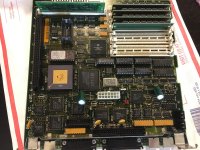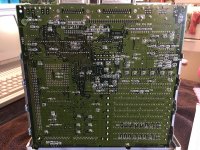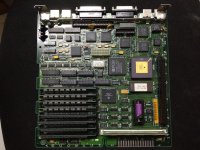just.in.time
Well-known member
Hi all,
I had an SE/30 board recapped by MacCaps. Originally, board was no boot/no audio whatsoever. It has made progress since being cleaned and recapped, audio now works. However, I'm still left with this as a result:

The startup chime is messed up, you can hear it in the following Youtube video:
https://youtu.be/D_z18h5slp8
What has been done so far is the following:
*Tested with three different SE/30 ROMs (2 known good, and 1 from this specific unit)
*Tested with several different combinations of RAM. Since in my possession after recapping I have personally tried 5Mb(4inA,1inB), 4Mb(4inA), and 1Mb(1inA), all with the same chime and image as above.
*Cleaned board several times
*Charles checked ~90 tracks by hand from the schematics, and all look good.
*I haven't bothered putting in a new PRAM battery yet, as that shouldn't affect the computer's ability to boot up.
Charles is thinking it could potentially be the RAM controller, if I'm understanding correctly.
Has anyone run into a similar (or the same issue) as this case? If so, what fixed it for you?
I have at my disposal a mediocre soldering iron, some solder, and a very basic digital multimeter. If anyone has simple instructions to follow along, I can probably swap some parts assuming my soldering skills (much like my soldering iron, they are mediocre at best) can keep up.
Here are some photos of the logic board:




I had an SE/30 board recapped by MacCaps. Originally, board was no boot/no audio whatsoever. It has made progress since being cleaned and recapped, audio now works. However, I'm still left with this as a result:

The startup chime is messed up, you can hear it in the following Youtube video:
https://youtu.be/D_z18h5slp8
What has been done so far is the following:
*Tested with three different SE/30 ROMs (2 known good, and 1 from this specific unit)
*Tested with several different combinations of RAM. Since in my possession after recapping I have personally tried 5Mb(4inA,1inB), 4Mb(4inA), and 1Mb(1inA), all with the same chime and image as above.
*Cleaned board several times
*Charles checked ~90 tracks by hand from the schematics, and all look good.
*I haven't bothered putting in a new PRAM battery yet, as that shouldn't affect the computer's ability to boot up.
Charles is thinking it could potentially be the RAM controller, if I'm understanding correctly.
Has anyone run into a similar (or the same issue) as this case? If so, what fixed it for you?
I have at my disposal a mediocre soldering iron, some solder, and a very basic digital multimeter. If anyone has simple instructions to follow along, I can probably swap some parts assuming my soldering skills (much like my soldering iron, they are mediocre at best) can keep up.
Here are some photos of the logic board:





